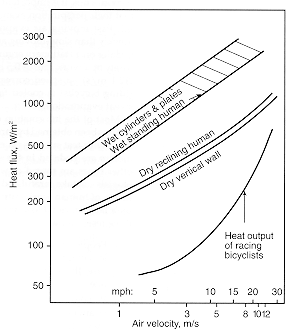| |
Because
the human body is not 100% efficient, the heat generated during activity must
be dissipated if sustained effort is to be maintained. Much of the work
of propelling a human powered vehicle at speed goes into overcoming air resistance.
This implies that in an open vehicle there is an adequate air flow over
the operator to provide the heat exchange required to remove waste heat.
In designing a vehicle with aerodynamic shrouding, however, provision must be
made for heat dissipation from the rider. Air intakes and exhaust ducts may
be required to achieve this.
The diagram shows the level of heat output
of a cyclist and compares this with heat losses. A body surface temperature
of 35 C, an air temperature of 15 C with a relative humidity 80%, and an
effective body surface area of the cyclist of 1.8 m2 is assumed.
The heat flux plotted on the vertical axis includes both convective and the
evaporative components of heat transfer to the air. This heat transfer is compared
to that achieved with a flat plate or cylinder at the same air velocity.
Evaporation of sweet is seen to be an important contribution to heat loss.
Body temperature will rise to dangerous levels if this cannot occur. Water
replacement is required for sustained activity. |
|
|
|
|
|
|
|
|
|
|
|
|
